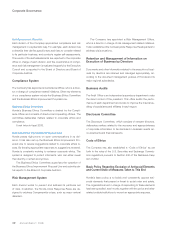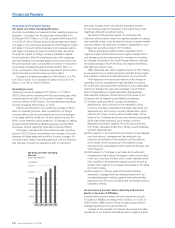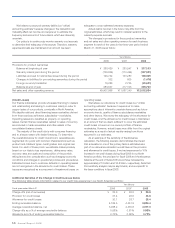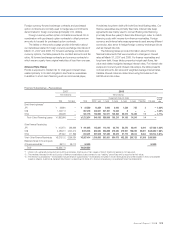Honda 2008 Annual Report Download - page 53
Download and view the complete annual report
Please find page 53 of the 2008 Honda annual report below. You can navigate through the pages in the report by either clicking on the pages listed below, or by using the keyword search tool below to find specific information within the annual report.
A n n u a l R e p o r t 2 0 0 8 5 1
revenue and the foreign currency effects, which offset the
negative impact of increased SG&A expenses.
Other Regions
In Other Regions, revenue increased ¥295.1 billion, or 37.0%,
to ¥1,092.8 billion, compared to the previous fiscal year, due
mainly to increased revenue in all of the business segments
and the positive impact of foreign currency translation effects.
Operating income rose ¥44.2 billion, or 61.2%, to ¥116.4
billion, from the previous fiscal year, due mainly to the positive
impact of the increased profit attributable to higher revenue,
the foreign currency effects, and continuing cost reduction
effects which offset the negative impact of increased SG&A
expenses.
Research and Development
Honda and its consolidated subsidiaries use the most
advanced technologies to conduct R&D activities aimed
at creating distinctive products that are internationally
competitive. The Group’s main R&D divisions operate
independently as subsidiaries, allowing technicians to
pursue their tasks with significant freedom. Product-related
R&D is spearheaded by the Honda R&D Co., Ltd.; Honda
R&D Americas, Inc. in the United States; and Honda R&D
Europe (Deutschland) GmbH in Germany. R&D on production
technologies centers around Honda Engineering Co., Ltd. in
Japan and Honda Engineering North America, Inc. All of these
entities work in close association with our other entities and
businesses in their respective regions.
Total consolidated R&D expenditures for the year ended
March 31, 2008 amounted to ¥587.9 billion.
Motorcycle Business
In the motorcycle business, Honda is committed to
developing products with new value-added features that
meet the individual needs of customers around the world,
and to implementing the timely local development of products
tailored to specific regions at its overseas locations. At the
same time, we are focusing on developing industry-leading
technologies that address safety and environmental issues.
Major developments in Japan in fiscal 2008 included
a full model change for the CBR600RR super sport bike.
Changes in the new model include a more compact engine
and a lighter-weight hollow aerial aluminum die-cast frame
that results in a substantial reduction in weight compared
with previous versions. The new model also features better
environmental performance and drivability owing to (a)
the introduction of a new electronic fuel injection system
(Programmed Dual Sequential Fuel Injection System) that
has two injectors per cylinder to provide a precise fuel
flow and the optimal air-oil ratio and (b) the installation of
a twin catalyzer. In addition, we introduced a new scooter
model, Lead, which boasts a newly developed, lighter and
more compact engine that combines high environmental
performance with sufficient power for smooth riding in urban
settings. Moreover, we fitted out our DN-01 680cc large
sports cruiser with Honda’s original, compact and efficient
infinitely variable hydraulic mechanical transmission (Human-
Friendly Transmission) complete with a lockup mechanism,
which features a diversity of functions within a single unit,
including power transmission on a single axle from the
start-up mode all the way to infinitely variable gear changing.
In North America, we newly introduced the high-powered
TRX700XX sport all-terrain vehicle (ATV), which is outfitted
with a newly designed liquid-cooled SOHC engine and an
electronic fuel injection system (PGM-FI).
R&D expenses in the Motorcycle Business segment in
fiscal 2008 totaled ¥91.7 billion.
Automobile Business
In the Automobile Business segment, we work to develop
innovative technologies and products through creativity-
oriented development in response to customer needs.
We are also actively developing technologies that address
environmental issues and provide advanced safety
performance.
Major achievements in Japan during the fiscal year under
review included a full model change for the FIT. The new FIT
combines a newly developed maximum 100 horsepower,
1.3-liter intelligent Variable Valve Timing and Lift, Electronic
Control (i-VTEC) engine and a newly developed Continuously
Variable Transmission (CVT) with a torque converter to provide
excellent driving performance and good fuel economy. Also,
we implemented a full model change for the INSPIRE in Japan
and for the Accord in North America, Asia and Other Regions.
The new versions boast high-level safety features and are
equipped with Honda’s newly developed 3.5-liter i-VTEC V6
engine with the new Variable Cylinder Management (VCM)
System that achieves high power and good fuel economy by
switching from the most powerful six-cylinder mode to four-
cylinder or three-cylinder mode for efficiency, depending on
driving conditions.
Another technology development milestone in the field of
fuel cell cars was the announcement of the FCX Clarity, which
is based on Honda’s original “V Flow” (vertical gas flow) fuel
cell platform. By employing Honda’s V Flow fuel cell stack,
which incorporates a wave flow separator where hydrogen
combines with atmospheric oxygen to generate energy that
is then converted to electric power used to propel the vehicle,
the new cell structure achieves a higher output of power and
considerably lower weight and smaller size. In addition to
this breakthrough in fuel cell vehicles, Honda has announced
the commencement of tests on the fourth-generation
Home Energy Station (Home Energy Station IV), which it is
developing jointly with Plug Power Inc., of the United States.
This unit can function both as a hydrogen supply source
for fuel cell cars and as a cogeneration system for electric
power. These units are undergoing pilot testing in Torrance,
California.
R&D expenses in the Automobile Business segment in
fiscal 2008 totaled ¥475.4 billion.
Power Product and Other Businesses
In the Power Product Business, we are seeking to develop
products that match customers’ lifestyles and needs
while strengthening our lineup of offerings that address
environmental issues.
Important developments in this segment in Japan and
other areas during the fiscal year included a full model change
in the BF40 and BF50 four-stroke marine outboard motors.
























